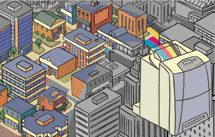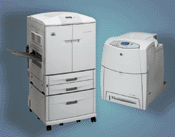Bold New HP Printers For SMBs
Nevertheless, not all businesses can afford every color laser printer available. And even though a printer might be targeted at the SMB market, it doesn't necessarily mean it's ideal for all SMBs.

Case in point: Hewlett-Packard's LaserJet 4600 and LaserJet 9500 models. While both of these color laser printers are targeted at the SMB space, the 9500 costs about three times as much as the 4600. So what's the difference between them? The CRN Test Center took a closer look.
The LaserJet 4600 is targeted at the SMB market because of its affordable price of $1,999. The printer doesn't take wide-format paper, but most small businesses would not need to print on 11 x 17 paper. The LaserJet 4600 competes directly against Xerox's Phaser 6250, one of the Test Center's favorite small-format color laser printers. The LaserJet 4600 costs less than the Xerox unit, which is priced at $2,499, but it's not quite as fast.
Fairly large for a small-format printer, the LaserJet 4600 measures 31.4 x 25.4 x 27.4 inches, and weighs 114 pounds. It's bigger (though mostly in height) and heavier than the Xerox unit, and therefore doesn't fit as well on a desktop. The LaserJet 4600 has a monthly duty cycle of 85,000 pages, and when the optional paper trays are used, the printer can hold 1,100 sheets of paper. Clearly, the LaserJet 4600 is well-suited for use as a small network printer.

The LaserJet 4600 prints in monochrome or color at 17 ppm, with the first page out in 18 seconds. Automatic duplexing is standard. Consumables are easy to replace, and a four-line control panel displays text and graphics simultaneously, making it easy for office workers to do basic troubleshooting and maintenance. It's perfect for small businesses without an IT staff on hand.
The LaserJet 4600 warms up in less than 90 seconds, which eliminates wait times and, in turn, lines of people standing at the printer. The printer is quick to set up, since just four toner cartridges have to be installed before it can be used. The cartridges slide into individual tracks behind the front panel, so there's no confusing carousel to deal with,as was the case with some older HP printers. Anyone can get this printer to work.
Output from the LaserJet 4600 is quite good, and it's a bit livelier with better contrast than Xerox's Phaser 6250. The LaserJet 4600's image quality, though, can't match that of its bigger brother, the LaserJet 9500. Positioned as a one-stop printing center, the LaserJet 9500 weighs nearly 300 pounds, stands 4 feet tall and costs $6,700 for the base model.

\
HP's LaserJet 9500 (l.) and 4600 are both targeted at the SMB market.
Both LaserJets, however, print at roughly the same speed. The LaserJet 4600 printed a 10-page monochrome Microsoft Word document in 53 seconds, with the first page out in 20 seconds. It also had the same scores, more or less, for a 10-page document containing color headings. The LaserJet 9500 took 50 seconds to print the 10-page monochrome Word document, with the first page out in 25 seconds. The 10-page Word document with color headings took 49 seconds to print, again with the first page out in 25 seconds.
HP says the LaserJet 9500 is targeted at the SMB market, based partly on its top-quality imaging, which lets anyone produce astounding looking documentation, and partly on all of the available finishing accessories, which can push the price up to around $10,000. Options include folding, saddle stitching, multiposition stapling and stacking, so any kind of flyer or brochure can be produced. Such production printing capabilities can save businesses thousands of dollars a year by enabling them to do their own projects in-house.
With an optional 2,000-sheet paper tray added, the LaserJet 9500 has an input capacity of 3,100 sheets. That, plus its 200,000 page-per-month duty cycle, means that the printer can support a lot of users on a big network. Of course, it can also print on 11 x 17 paper. SMBs that must print on 11 x 17 paper,and ones that have to produce professional-looking brochures as quickly as possible,should look to the LaserJet 9500 to meet their needs. Otherwise, the LaserJet 4600 would be more than sufficient.